Operators
 United Kingdom
United Kingdom
| Admiralty Type 74 | |
|---|---|
| General information | |
| Type | Military reconnaissance biplane seaplane |
| Manufacturer | Short Brothers |
| Designer | |
| Primary user | Royal Navy |
| Number built | 7 |
| History | |
| Manufactured | Eastchurch |
| Introduction date | 1914 |
| First flight | 4 January 1914 |
| Developed from | Short Admiralty Type 42 |
The Short Admiralty Type 74 was a single-engined biplane tractor seaplane with non-folding wings, which saw service with the Royal Naval Air Service during the First World War.
The Type 74 incorporated some of the innovations Horace Short had introduced to the Short Admiralty Type 42, including manganese-steel tube struts instead of wood. In addition to the two main rubber-sprung floats below the fuselage and the single tail float, it also had smaller floats attached below the lower wingtips. Ailerons were mounted on the upper wing only, the latter extending beyond the span of the lower wing. The extensions were braced by diagonal struts to the lower wingtips.
Since it was intended for use as a coastal patrol seaplane operating from coastal stations, there was no requirement for the Type 74 to have folding wings. [1]
The Type 74 was powered by a 100 hp (74.6 kW) Gnome double Omega engine, which provided a maximum flight duration of five hours. [2]
In 1913 the Royal Navy ordered seven 100 hp biplane seaplanes from Shorts, which were assigned the company's serial numbers 69-75. The first of these flew on 4 January 1914, piloted by Gordon Bell, Chief Test Pilot at Shorts. He was accompanied on this first flight by Charles Richard Fairey (later Sir Richard Fairey), who left Shorts in 1915 to found the Fairey Aviation company. When this first aircraft was delivered to the Royal Navy air station on the Isle of Grain it received the Navy's serial number 74, so this and the remaining six aircraft from the batch (Navy numbers 74-80) were therefore known as the Admiralty Type 74 according to the rules in use at the time.
Of the seven aircraft, four (including Naval nos. 75 and 79) were dispatched to the air station at Dundee, the other three remaining at the Grain air station. The Dundee aircraft took part in the 1914 Royal Fleet Review off Spithead as part of a contingent of 17 seaplanes and four airships. [3]
Data from Shorts Aircraft since 1900 [4]
General characteristics
Performance

The Fairey Aviation Company Fairey III was a family of British reconnaissance biplanes that enjoyed a very long production and service history in both landplane and seaplane variants. First flying on 14 September 1917, examples were still in use during the Second World War.

The Sopwith Tabloid and Sopwith Schneider (floatplane) were British biplanes, originally designed as sports aircraft and later adapted for military use. They were among the first successful types to be built by the Sopwith Aviation Company. The "Tabloid", so named because of its small size, caused a sensation when it made its first public appearance.
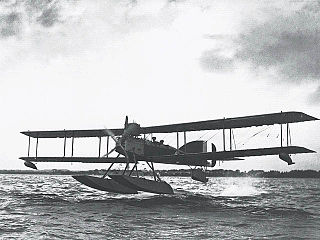
The Short Admiralty Type 184, often called the Short 225 after the power rating of the engine first fitted, was a British two-seat reconnaissance, bombing and torpedo carrying folding-wing seaplane designed by Horace Short of Short Brothers. It was first flown in 1915 and remained in service until after the armistice in 1918. A Short 184 was the first aircraft to sink a ship using a torpedo, and another was the only British aircraft to take part in the Battle of Jutland.
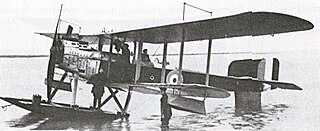
The Fairey Campania was a British ship-borne, patrol and reconnaissance aircraft of the First World War and Russian Civil War. It was a single-engine, two-seat biplane with twin main floats and backward-folding wings. The Campania was the first aeroplane ever designed specifically for carrier operations.
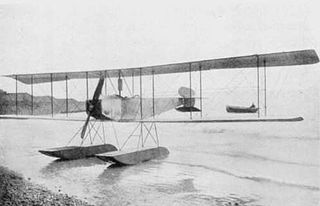
The Avro Type H, Type 501, and Type 503 were a family of early British military seaplanes. They were a development of the Avro 500 design and were originally conceived of as amphibious, the prototype being fitted with a single large main float under the fuselage, and two outrigger floats under the wings.

The Bristol T.B.8, or Bristol-Coanda T.B.8 was an early British biplane built by the Bristol Aeroplane Company and designed by the Romanian Henri Coandă. Fifty four Bristol T.B.8s were built, being mainly used as a trainer. A small number of Bristol T.B.8s were briefly used as bombers at the start of the World War I by the Royal Naval Air Service.
The Sopwith Admiralty Type 807 was a 1910s British biplane seaplane designed and built for the Admiralty by the Sopwith Aviation Company.

The Sopwith Admiralty Type 860 was a 1910s British biplane seaplane torpedo bomber designed and built for the Admiralty by the Sopwith Aviation Company.

The Short Type 827 was a 1910s British two-seat reconnaissance floatplane. It was also known as the Short Admiralty Type 827.

The Short Type 166 was a 1910s British two-seat reconnaissance, bombing and torpedo-carrying folder seaplane, designed by Short Brothers.
The Short N.2B was a prototype British patrol seaplane of the First World War, designed and built by Short Brothers. A single-engined biplane intended to replace Short's successful Type 184, only two were built, the Fairey III being preferred.

The Sopwith Three-seater was a British aircraft designed and built prior to the start of the First World War. One of the first aircraft built by the Sopwith Aviation Company, it was operated by both the Royal Naval Air Service (RNAS) and the Royal Flying Corps (RFC), being used briefly over Belgium by the RNAS following the start of the War.
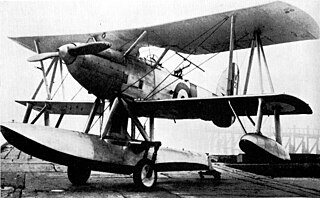
The Short Gurnard was a single-engined two-seat biplane naval fighter, built in the United Kingdom to an Air Ministry specification in 1929. It failed to win production orders and only two flew.

The Short S.41 was a British single-engined biplane built for the Royal Navy in 1912. Capable of being operated either on wheels or floats, it was successful enough for a further two similar aircraft to be built, with the type remaining in use until the early years of the First World War.
The Short S.45 — also known as the Short T.5 after its naval serial number — was a training biplane built for Britain's Royal Navy by Short Brothers in 1912. It was the forerunner of another three identical aircraft delivered to the Royal Navy and Royal Flying Corps during 1912 and 1913. The Royal Naval Air Service was still operating the type when World War I broke out in 1914.

The Dunne D.8 of 1912 was a tailless swept wing biplane, designed by J. W. Dunne to have inherent stability. One example was supplied to RAE Farnborough. License-built Burgess-Dunne models were used by the US Signal Corps and United States Navy and the short-lived Canadian Aviation Corps. It was the latter's first and only warplane.

The Short S.27 and its derivative, the Short Improved S.27, were a series of early British aircraft built by Short Brothers. They were used by the Admiralty and Naval Wing of the Royal Flying Corps for training the Royal Navy's first pilots as well as for early naval aviation experiments. An Improved S.27 was used by C.R. Samson to make the first successful take-off from a moving ship on 9 May 1912.
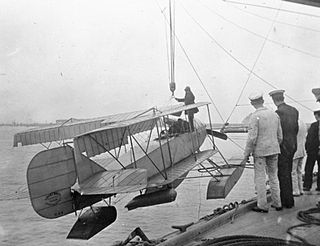
The Short Admiralty Type 81 was a series of British two-seat floatplanes built prior to the First World War, and used by the Royal Naval Air Service in the early years of the war. They were powered by 160 hp (120 kW) Gnome Lambda-Lambda 14 cylinder two-row rotary engines and had folding wings to aid storage on ship, hence the popular name Short Folder, shared with a number of other seaplanes made by Short Brothers.
The Sopwith Special torpedo seaplane Type C was the first British aircraft designed to drop torpedoes. A single-engine biplane floatplane, it flew in July 1914 but proved unable to lift the design load and was soon abandoned.
The Short S.80 was an early British floatplane built by Short Brothers for Frank McClean to undertake an aerial expedition up the Nile to investigate the cataracts between Aswan and Khartoum. After a successful flight to Khartoum it was returned to England, where it was used for training by the RNAS. When built it was the largest successful aircraft that had been constructed in Britain. It was also known as the Short Nile Pusher Biplane Seaplane.